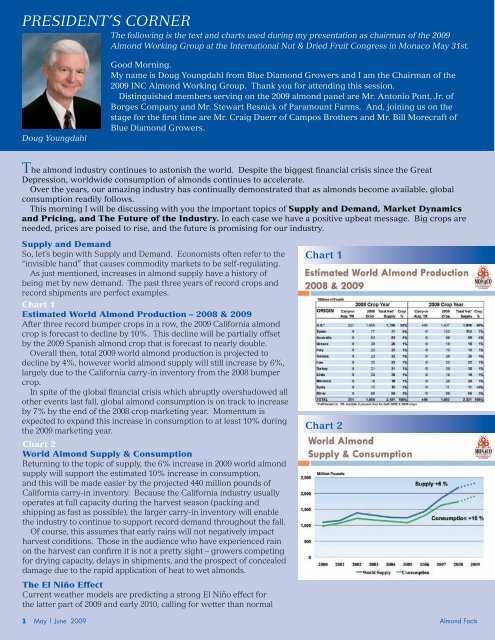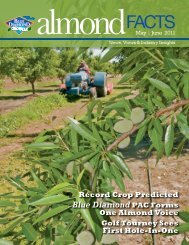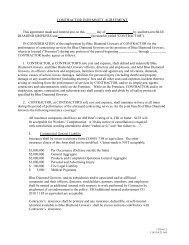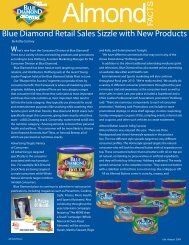PRESIDENT'S CORNER - Blue Diamond Growers
PRESIDENT'S CORNER - Blue Diamond Growers
PRESIDENT'S CORNER - Blue Diamond Growers
Create successful ePaper yourself
Turn your PDF publications into a flip-book with our unique Google optimized e-Paper software.
PRESIDENT’S <strong>CORNER</strong>The following is the text and charts used during my presentation as chairman of the 2009Almond Working Group at the International Nut & Dried Fruit Congress in Monaco May 31st.Doug YoungdahlGood Morning.My name is Doug Youngdahl from <strong>Blue</strong> <strong>Diamond</strong> <strong>Growers</strong> and I am the Chairman of the2009 INC Almond Working Group. Thank you for attending this session.Distinguished members serving on the 2009 almond panel are Mr. Antonio Pont, Jr. ofBorges Company and Mr. Stewart Resnick of Paramount Farms. And, joining us on thestage for the first time are Mr. Craig Duerr of Campos Brothers and Mr. Bill Morecraft of<strong>Blue</strong> <strong>Diamond</strong> <strong>Growers</strong>.The almond industry continues to astonish the world. Despite the biggest financial crisis since the GreatDepression, worldwide consumption of almonds continues to accelerate.Over the years, our amazing industry has continually demonstrated that as almonds become available, globalconsumption readily follows.This morning I will be discussing with you the important topics of Supply and Demand, Market Dynamicsand Pricing, and The Future of the Industry. In each case we have a positive upbeat message. Big crops areneeded, prices are poised to rise, and the future is promising for our industry.Supply and DemandSo, let’s begin with Supply and Demand. Economists often refer to the“invisible hand” that causes commodity markets to be self-regulating.As just mentioned, increases in almond supply have a history ofbeing met by new demand. The past three years of record crops andrecord shipments are perfect examples.Chart 1Estimated World Almond Production – 2008 & 2009After three record bumper crops in a row, the 2009 California almondcrop is forecast to decline by 10%. This decline will be partially offsetby the 2009 Spanish almond crop that is forecast to nearly double.Overall then, total 2009 world almond production is projected todecline by 4%, however world almond supply will still increase by 6%,largely due to the California carry-in inventory from the 2008 bumpercrop.In spite of the global financial crisis which abruptly overshadowed allother events last fall, global almond consumption is on track to increaseby 7% by the end of the 2008 crop marketing year. Momentum isexpected to expand this increase in consumption to at least 10% duringthe 2009 marketing year.Chart 2World Almond Supply & ConsumptionReturning to the topic of supply, the 6% increase in 2009 world almondsupply will support the estimated 10% increase in consumption,and this will be made easier by the projected 440 million pounds ofCalifornia carry-in inventory. Because the California industry usuallyoperates at full capacity during the harvest season (packing andshipping as fast as possible), the larger carry-in inventory will enablethe industry to continue to support record demand throughout the fall.Of course, this assumes that early rains will not negatively impactharvest conditions. Those in the audience who have experienced rainon the harvest can confirm it is not a pretty sight – growers competingfor drying capacity, delays in shipments, and the prospect of concealeddamage due to the rapid application of heat to wet almonds.The El Niño EffectCurrent weather models are predicting a strong El Niño effect forthe latter part of 2009 and early 2010, calling for wetter than normalChart 1Chart 21 May | June 2009 Almond Facts
conditions during the latter part of harvest. For those notfamiliar with El Niño, it is one of nature’s most powerful weatherphenomena and it involves the climate of the Pacific Ocean inthe region around the equator. It affects both the ocean andthe atmosphere and it generally results in a wet winter in theSouthwestern U.S. and drought in Indonesia and Australia. Theweather models used are very complex and designed to predict ElNiño’s 12 to 18 months in advance.Ironically, even one heavy rain season may not break California’sself-imposed drought for the Westside of the San Joaquin Valley.Regulations and the Endangered Species Act will continue toaffect the quantity of water that can be shipped south where it isbadly needed for years to come. In addition, competing interestsfrom urban population centers are ever-present.Chart 3California Almond Shipment TrendsReturning to the topic of shipments, 2008 crop year Californiashipments are expected to end the year up 7%. This equates to1.35 billion pounds. It is worthwhile to expand our focus beyondthese statistics because taken alone they do not emphasize theindustry’s current robust shipping momentum.While cumulative shipments from August 2008 through January2009 were flat compared to the prior year, shipments during thefinal six months (February through July 2009) are expected toexceed the prior year by a phenomenal 16%.Given this momentum, the forecasted 9% growth in shipmentsduring the 2009 crop year to 1.475 billion pounds may well beconservative.Chart 4CA Almond Carry-In as Percent of Prior YearShipmentsAs already noted, the 2008 crop carry-in or working inventoryas of August 1, 2009 is estimated to be approximately 440 millionpounds.While this carry-in amount as a percent of prior year shipmentsis forecast to be the peak for this decade, it remains considerablylower than comparative levels twenty years ago.The smaller 2009 California crop will provide time for marketdemand to catch-up with supply. This will reduce the carry-ingoing forward and evidence of this can be seen in the lower carryinshown on this chart for 2010.Price DynamicsTurning now to the topic of price dynamics – the 2008 crop yearhas been characterized by most observers as a two-tier market inwhich the entire spectrum of almond prices represent excellentvalue for customers.Chart 5Historical Almond PricingReflected on this chart are market prices over the last seven yearsfor “California Select Sheller Run” almonds in both US dollars andEuros.As a result of three record California crops in a row, supply hastemporarily outpaced the increase in demand. This is becausethe double-digit consumption increases normally expected in abumper crop year were held to 7% by the global financial crisis.As a result, market prices have fallen to levels not seen since thebeginning of the decade. Prices in Euros are at historical lows.Chart 3Chart 4Chart 5– Continued on next pageAlmond Facts May | June 2009 2
PRESIDENT’S<strong>CORNER</strong>– Continued frompage 3Chart 6Chart 6Widening Two-tier MarketThe market differential between Nonpareil Supreme and “BlanchableStandard Sheller Run” has never been greater than it is today.This price differential reflects the tight balance between supplyand demand that exists for the Nonpareil variety versus genericblanchable small count almonds that are less in balance.Given that the 2009 Nonpareil crop is expected to decline even morethan other varieties, the price differential is expected to continue oreven grow in the coming year.Consequently, upward price pressure on other varieties can beexpected as buyers look for alternatives to Nonpareil Supreme.Chart 7Tree Nut Price/Lb.Almond prices today represent a bargain compared to other tree nuts.Even the premium Nonpareil Supreme almonds, shown separatelyfrom California SSR almonds, are competitively attractive. 2009 cropgeneric small count blanchable almonds would, if shown on thischart, be at a level around $1.10/lb. Unquestionably, almonds overallare a fantastic value.FutureNow let’s focus on future events affecting our industry.Chart 8California Almond Bearing AcreageThe 65,000 bearing acres planted in 2006, less acreage pullouts,have caused total bearing acres to increase from 680,000 to 710,000acres for the 2009 crop year as reported by the National AgriculturalStatistics Service (NASS).Bearing acres are anticipated to increase again in 2010 although theincrease should not be as significant because 20,000 fewer acres wereplanted in 2007 than in 2006.Thereafter, bearing acreage may well decline as pullouts areexpected to exceed the rate of new plantings as evidenced by the nextslide.Chart 7Chart 83 May | June 2009 Almond Facts
Chart 9Chart 9California Almond Orchards – Estimated Age of AcreageCurrently there are 130,000 acres over 20 years old. This is a significantpercentage of orchards in California. The recent decline in marketprices will accelerate the removal of these orchards that are rapidlybecoming non-economical.In the near term, new plantings will decline dramatically untildemand catches supply and market prices support sustainable returnsto growers.Chart 10Chart 10California Almond Production/Shipment TrendLarger California almond crops have supported a greater globalconsumption growth rate trend during the past five years that has beentracking at 8.5% compounded annually.In accordance with this trend, shipments for the 2009 crop year areexpected to increase by 9%. This slide shows low-to-high productionestimates with the expected shipment growth trend, illustrating thatsupply and demand come into balance in future years.Chart 11Estimated 2008 Per Capita Consumption in World MarketsCompared to 1.3 pounds per capita consumption in the United States,the weighted average in emerging markets is only .07 pounds –representing huge growth opportunities for the almond industry.For example, during the current year, China has more than doubledtheir imports of California almonds, India has increased by almost 12%,and in addition the Middle East has increased their imports by 45%.It is worth noting that China, should they repeat recent increasesin consumption, may soon become the number one export market forCalifornia almonds. It is even conceivable that by the time we all cometogether in Beijing next year, China will have reached that landmark.Chart 11Outlook SummaryIn closing, let’s return to the assertions made in my opening statement.Big crops are needed...v Consumption in India, the Middle East and China will continue toaccelerate, supporting record worldwide growth.Prices are poised to rise...v As demand catches supply, market prices will rise fromnear-historic lows.The future of our industry is promising...v Global consumption will continue to increase, sustaining thelong-term growth of our industry. This will be driven by a powerfuland ever-growing consumer awareness of the great taste andnutritional benefits of almonds.This concludes my remarks, thank you for your kind attention.Almond Facts May | June 2009 4











